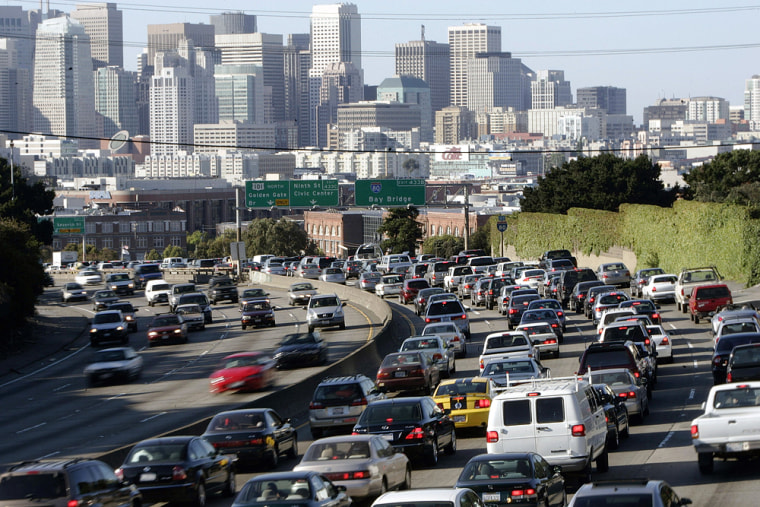Will you save more money buying a nice affordable house in the suburbs and making a long commute to work each day, or buying a pricey city apartment with your job only a couple of subway stops away?
A recent study by the Washington D.C.-based Center for Housing Policy found that the trade-off of a suburban existence for a cramped city apartment doesn't always add up. The report concluded that for lower income people, the combined costs of housing and transportation are about the same in most major metropolitan regions across the country. But it doesn't just apply to those earning between $20,000 and $50,000.
Aside from the very wealthy who can afford to commute how and when they choose, moving from the city to the country no longer makes as much sense financially as it used to.
The data in the Center for Housing Policy report, entitled "A Heavy Load: The Combined Housing & Transportation Burdens of Working Families," focuses on the burdens of households with income levels between $20,000 and $50,000, but the findings also hold true for middle- and high-income households.
While the give-and-take between housing and transportation is consistent for all income levels, higher income households typically pay below average shares for both expenditures.
Using research from the Chicago-based Center for Neighborhood Technology, as well as from Virginia Tech, the Center for Housing Policy researchers quantified the number of households paying below-average shares of their income on both housing and transportation, above average for transportation, above average for housing, and above average for both housing and transportation, in the 28 metropolitan regions identified by the U.S. Bureau of Labor Statistics' 2003-04 Consumer Expenditure Survey.
In every one of the 28 cities cited in the report, middle- and higher-income households spent more on housing, while the main cost for working families varied by city. Of households with incomes between $50,000 and $250,000, the three cities with the highest combined shares of housing and transportation expenses in the report were San Francisco, Seattle, and Chicago, at 34.4 percent, 33 percent, and 33 percent of incomes respectively.
San Francisco households have by far the most stratified expenditures, with 21.7 percent of residents' incomes spent on housing, and 12.7 percent spent on transportation. This can be attributed to pockets of wealthy neighborhoods within close proximity to employment centers, where some of the most expensive properties in the country sit less than 10 miles from downtown. These suburbs have the effect of pushing working-class families farther out from the city, thereby increasing traffic congestion for the whole system.
Frequently, families who relocate away from cities like San Francisco fail to prepare for the high cost of the car culture they enter. "Transportation means not only going to work, but if you're living in one of the outlying suburbs, it means you need a car to do absolutely everything," says Barbara Lipman, research director for the report. "I think it's important to consider your total costs."
Seattle exhibits similar characteristics as San Francisco, but middle- to high-income households there spend a little more on transportation (14 percent) and a little less on housing (19 percent). This is partly because property costs are much less exorbitant, but also because employment centers are much more concentrated around the downtown area.
In cities like Seattle, the Center for Housing Policy advocates infill development to help provide affordable housing to inner city areas, older suburban areas with easy access to employment centers, and transportation hubs. "Why not use [local] grant money to reward localities that are willing to build more affordable housing or provide more transportation options?" proposes Lipman.
Middle- to high-income families in Chicago also spend a 33 percent combined share of housing and transportation, but the picture there is much different. Outlying suburbs house wealthier families, while working families who spend above-average on housing and transportation are close to the urban center.
The Center for Housing Policy attributes this situation to an extensive transit system that "provides good corridor service from suburbia to downtown, but poor service to suburban job centers." They call this a "doughnut effect": higher-income workers commute into the city while lower-income workers commute outward to the suburbs, a trend also seen in San Diego, Atlanta, and Phoenix.
In a related study released shortly after this one, "Commuting in America III," the Transportation Research Board finds that more and more employers are moving out into the suburbs, that there are more drivers going from suburb to suburb, and that the number of workers with one-way commutes greater than 60 minutes has raised significantly.
The Transportation Research Board also looked at transportation spending by income level, and found that upper-middle-class consumers spend the highest share of income on transportation, 20.56 percent, while lower-class consumers spend the lowest share, 17.23 percent.
